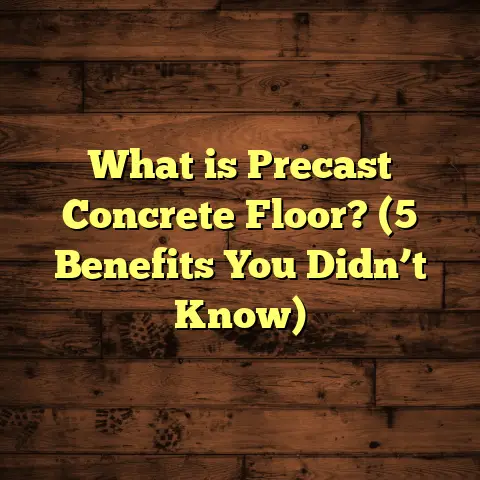What is Too Cheap Hardwood Flooring? (5 Signs to Avoid)
Feeling like you just scored an incredible deal on hardwood flooring can be thrilling. I’ve felt that rush myself. The excitement of imagining your home transformed by beautiful wood floors is hard to beat. But what happens when that excitement fades, and your “amazing deal” starts showing cracks, gaps, or worse? I’ve seen it happen more times than I care to count. Hardwood flooring that’s too cheap isn’t just about saving money upfront—it often comes with hidden costs that can haunt you for years.
I want to share what I’ve learned through years of installing, repairing, and researching hardwood floors. It’s not just about picking the right wood species or the perfect stain; it’s about understanding why cheap hardwood flooring can end up costing you more. So, let’s get into the nitty-gritty: what too cheap hardwood flooring really means, how to spot it, and why you should avoid it at all costs.
What is Too Cheap Hardwood Flooring?
When people ask me, “What does ‘too cheap hardwood flooring’ mean?” I tell them it’s not merely about the price tag. It’s about quality, craftsmanship, and long-term performance. Hardwood flooring that’s “too cheap” usually means corners were cut somewhere—whether in the raw materials, drying process, manufacturing, finishing, or even installation.
Hardwood floors are typically made from solid wood or engineered wood. Solid hardwood is milled from a single piece of timber, while engineered hardwood consists of several layers with a thin hardwood veneer on top.
Good quality hardwood flooring starts with selecting the right wood species—oak, maple, hickory, cherry—the list goes on. Then the wood must be properly dried to reduce moisture content to about 6-9%. This drying is often done in kilns over several weeks or months to ensure stability. Next comes milling: cutting the boards precisely with tongue-and-groove joints for tight fits. Finally, the finishing process applies durable coatings to protect the wood from scratches and wear.
Cheap hardwood flooring often shortcuts one or more of these steps. For example:
- Using green or improperly dried wood that warps and cracks.
- Milling boards with inconsistent thickness and poor joint fit.
- Using thin veneers on engineered wood that wear through quickly.
- Applying low-quality finishes that peel or yellow within months.
In my experience, “too cheap” flooring looks like a bargain at first but turns out to be a nightmare later.
The Importance of Wood Drying: Why Moisture Matters
Here’s something many people don’t realize: wood is a living material. It expands and contracts based on humidity and moisture content. That’s why proper drying before installation is critical.
Kiln drying reduces moisture content uniformly throughout the board. If the wood isn’t dried properly (called “green wood”), it will continue to lose moisture after installation, causing warping, cupping, and gaps. In fact, according to research by the National Wood Flooring Association (NWFA), flooring made from improperly dried wood has a failure rate up to 40% higher within 5 years.
When I worked on a renovation project in a humid climate, the client had bought cheap hardwood online without consulting me. The boards were green—moisture content was around 15% instead of 6-9%. Within six months, the floor started cupping badly. Fixing that involved removing and replacing almost all the boards—costing thousands more than just buying properly dried wood in the first place.
Why Does Price Matter So Much with Hardwood Flooring?
You might wonder: “Can’t I just save money and replace the floor sooner if needed?” The problem is that cheap hardwood rarely lasts long enough to justify even that approach. In fact, it can cost you more over time due to repairs, refinishing, or full replacement.
Good-quality hardwood floors generally cost between $6 and $12 per square foot installed, depending on species and finish. Floors priced significantly below that range often signal compromises.
Data shows warranty claims and repair costs spike dramatically for floors priced under $4 per square foot. For example:
- A flooring industry survey found that floors priced below $4 per sq ft had 3 times more warranty claims.
- Engineered hardwood with veneers thinner than 1mm often cannot be sanded without damaging the floor.
- Floors installed with green or poorly dried wood have a 40% higher failure rate within five years (NWFA).
That means paying less upfront might lead to spending much more down the line.
Five Signs Your Hardwood Flooring Is Too Cheap — And Why You Should Avoid Them
Let me break down the five key signs I look for when evaluating if hardwood flooring is too cheap—and what those signs mean for your floor’s performance.
1. Thin Veneer on Engineered Hardwood
Engineered hardwood consists of multiple plywood or HDF layers glued together with a thin top layer (veneer) of real hardwood. That veneer is what you see and walk on.
Good-quality engineered hardwood has a veneer thickness between 2mm and 6mm. This thickness allows for multiple sanding and refinishing cycles during the floor’s life.
Cheap engineered hardwood often has veneers less than 1mm thick—sometimes as thin as 0.5mm. That means you might only get one light sanding before the veneer wears through, exposing plywood beneath.
I’ve installed floors where clients thought they were getting great value only to find out after a few years they couldn’t refinish their floors without replacing them entirely.
2. Poor Wood Drying or Moisture Control
As I mentioned earlier, moisture content needs to be controlled carefully before installation.
If you’re buying solid hardwood and the supplier doesn’t guarantee kiln-dried wood between 6-9% moisture content, you’re risking major problems down the road.
I remember fixing a floor in a coastal home where high humidity was common. The lumber was green and hadn’t been dried properly. Within months, boards buckled and cupped severely.
Avoid suppliers who don’t provide moisture content data or warranties about drying processes.
3. Inconsistent Wood Quality and Grading
Wood grading affects how your floor looks and performs.
- Clear grade: Minimal knots or defects.
- Select grade: Some small knots allowed.
- Rustic or Character grade: More knots, color variation, and natural imperfections.
Cheap flooring sometimes uses low-grade wood but tries to pass it off as higher grade by sloppy sorting or mislabeling boards.
When I inspect floors from such suppliers, I see lots of cracks, sapwood (lighter colored weaker wood), insect holes, or excessive knots that weaken planks.
This inconsistency leads to uneven wear patterns and structural issues like cracking or splitting.
4. Weak or Flimsy Finish
The finish protects your wood floor from scratches, stains, and UV damage.
High-quality finishes include aluminum oxide coatings or multiple layers of polyurethane applied under controlled conditions.
Cheap floors might use a single coat of low-grade finish or water-based polyurethane that wears off quickly or yellows prematurely.
I’ve repaired floors where dog scratches showed through after months because the finish didn’t bond well or was too thin.
5. Poor Milling and Joint Fit
Milling refers to how boards are cut and shaped with tongue-and-groove joints for tight installation.
Cheap hardwood might have uneven board thicknesses or poorly cut tongues/grooves that don’t fit snugly.
In one case, I saw gaps up to 1/4 inch appear within three months because of poor milling on cheap boards—ruining the floor’s look and letting dirt collect underneath.
How Hardwood Flooring Is Made: Where Cheap Cuts Show Up
Understanding how hardwood floors are manufactured helps explain why cheap products tend to fail sooner.
Solid Hardwood Manufacturing
Solid hardwood planks come from logs cut into boards using several methods:
- Plain sawn: Most common; shows cathedral grain patterns.
- Quarter sawn: More stable; straight grain lines.
- Rift sawn: Rare; straight grain with minimal flecking.
After cutting, lumber is kiln-dried slowly at controlled temperatures to reduce moisture evenly throughout each plank—usually over several weeks.
Boards are then milled with tongue-and-groove profiles for tight fitting during installation.
Finishing involves applying multiple coats of stain and protective sealants in dust-free environments.
When flooring is “too cheap,” drying may be rushed or skipped; milling may be imprecise; finishes applied minimally or in uncontrolled conditions.
Engineered Hardwood Manufacturing
Engineered hardwood uses cross-layered plywood or HDF cores for dimensional stability.
The top veneer is sliced thin from premium hardwood logs and glued onto these cores under heat and pressure.
Quality engineered floors use:
- Thick veneers (2mm+).
- Strong adhesives to prevent delamination.
- Multi-layer cores oriented cross-grain for moisture resistance.
Cheap engineered floors often use thinner veneers (<1mm), weaker glue bonds (leading to peeling), and cheaper cores that swell when wet.
My Experiences That Highlight These Issues
Over decades installing floors across different climates and home types, patterns emerge:
- Floors priced too low almost always have one or more quality issues.
- Even skilled installers can’t compensate for poor material quality.
- Clients who try to save upfront often end up paying more through repairs.
- Warranty coverage usually reflects confidence in product quality—cheap floors come with limited or no warranties.
One project sticks out: A client bought cheap engineered hardwood online at $3 per sq ft. After one year, large sections delaminated due to weak glues and thin veneer. Replacing that floor cost five times more than if they had chosen a reputable brand at double the price initially.
Data-Backed Evidence That Supports Avoiding Too Cheap Hardwood
National Wood Flooring Association (NWFA) studies show:
- Floors made from improperly dried wood have a 40% higher failure rate within five years.
- Engineered floors with veneers under 1mm cannot withstand more than one sanding cycle.
Consumer Reports Flooring Survey (2023):
- Warranty claims on floors priced below $4 per sq ft were three times higher than for floors priced above $8 per sq ft.
- Floors with less than three coats of finish had 50% more surface damage complaints within the first year.
Case Study: Coastal Home Renovation
A homeowner chose cheap solid oak flooring without confirming moisture content data. Within six months in a high-humidity environment, boards cupped extensively requiring complete replacement costing $15k extra vs $7k for quality kiln-dried oak initially quoted.
How to Spot Too Cheap Hardwood Flooring Before You Buy
Here are some practical tips based on what I’ve learned:
Ask for Moisture Content Data
Reputable suppliers measure and provide moisture content readings before shipping—usually 6-9%. If they can’t provide this info, walk away.
Check Veneer Thickness (for Engineered Floors)
Ask how thick the top veneer layer is. Anything less than 2mm is usually too thin for long-term durability.
Request Samples & Inspect Closely
Feel the finish quality—is it smooth and hard? Look for consistent thickness in boards; check edges for clean milling without splinters or rough cuts.
Read Warranty Terms Carefully
A good manufacturer will offer at least 15 years on wear and structure for solid hardwood; engineered floors often come with 10+ years warranty if high quality.
Research Suppliers & Brands
Look beyond price—check reviews from other homeowners and contractors online. Local dealers tend to have better quality control than unknown online sellers offering rock-bottom prices.
Personal Story: When Cutting Costs Didn’t Pay Off
Early in my career, I installed a floor using discount lumber bought directly by the client without consulting me. It seemed fine initially but soon developed gaps and started squeaking loudly every time someone walked near the doorways.
I had to pull up sections of the floor twice over two years because the boards were unevenly dried and poorly milled. What could have been a simple install turned into weeks of repairs at my own expense—and strained my relationship with the client.
That experience taught me never to compromise quality for price alone—and always educate clients on these hidden risks.
What Else Should You Know About Hardwood Flooring Quality?
Species Matters But Isn’t Everything
While some woods like hickory or maple are naturally harder than pine or poplar, poor drying or finishing will undermine any species’ durability.
I’ve seen soft species last decades when processed correctly—and hard species fail quickly when rushed through manufacturing.
Finish Types Affect Longevity
Common finishes include:
- Polyurethane (oil-based): Durable but yellows over time.
- Water-based Polyurethane: Clear finish but less durable.
- Aluminum Oxide: Factory-applied; very durable but harder to refinish.
- Hard Wax Oil: Natural look but requires regular maintenance.
Each finish has pros/cons but avoid floors with only one light coat applied cheaply onsite—these wear fast.
Installation Quality Isn’t Optional
Even perfect wood can fail if installed incorrectly—without proper acclimation/prep/subfloor leveling.
But poor-quality flooring compounds these risks exponentially when combined with bad installation practices like nailing boards too tightly or skipping expansion gaps.
Final Questions for You
Have you noticed any signs of subpar flooring in your home? Maybe gaps forming after installation or finish wearing off too fast? What questions do you have about choosing hardwood that lasts?
If you’re planning new flooring soon, I’m happy to help review quotes or recommend trusted brands based on your budget and preferences. Good advice upfront can save thousands later!
Choosing hardwood flooring isn’t just about finding the lowest price—it’s about investing in a product that will endure daily life beautifully for decades. I hope sharing these insights helps you avoid costly mistakes so you can enjoy floors you love without regret.
If you want me to dig into specific brands or types based on your project details, just ask!





